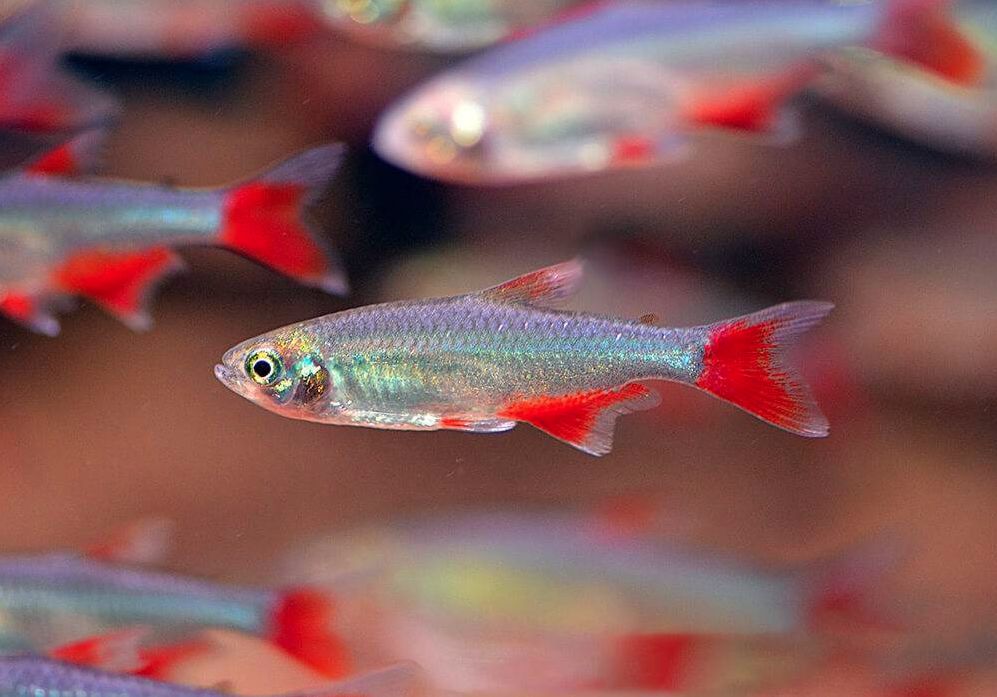Are you looking for a captivating addition to your aquarium? The Bloodfin Tetra might be just what you need.
With its distinctive bright red fins and shimmering silver body, this fish will catch your eye in no time.
It thrives in freshwater habitats and prefers to swim in schools, making it a social and active species.
As you learn more about the Bloodfin Tetra’s habitat, physical characteristics, and care requirements, you’ll be well-equipped to provide a happy and healthy environment for this stunning fish.
Habitat and Natural Distribution
In their natural habitat, bloodfin tetras can be found in the clear, fast-flowing rivers of South America. These small freshwater fish are native to countries such as Brazil, Argentina, and Paraguay. Bloodfin tetras are well adapted to their environment, displaying a silver body with red fins that allow them to blend in with the surrounding vegetation. They inhabit areas with dense vegetation and prefer water temperatures between 72 and 78 degrees Fahrenheit.
Natural predators of bloodfin tetras include larger fish, birds, and aquatic mammals. These tetras are known for their strong schooling behavior and often migrate within their river habitats in search of food and suitable breeding grounds. Studying the migration patterns of bloodfin tetras provides valuable insights into their reproductive habits and overall population dynamics.
Physical Characteristics and Appearance
You can easily identify the bloodfin tetra by its vibrant red fins and sleek, silver body. This small freshwater fish has a size range of 1.5 to 2 inches, making it a popular choice for aquarium enthusiasts. With a lifespan of up to 5 years, the bloodfin tetra can bring color and activity to your tank for a significant period. Its color variations are limited, but still intriguing.
The three main color variations you can find are:
- Red Fins: The bloodfin tetra’s most distinctive feature is its bright red fins, which contrast beautifully against its silver body.
- Silver Body: The fish has a sleek, silver body that reflects light, giving it a shimmering appearance.
- Black Eye: The bloodfin tetra has a distinct black eye, adding to its overall unique look.
Overall, the bloodfin tetra is a visually striking fish that can add a vibrant touch to any aquarium.
Tank Setup and Water Conditions
To create the optimal habitat for your bloodfin tetra, make sure to provide a well-filtered tank with a temperature range of 72 to 82 degrees Fahrenheit. Maintaining the proper water conditions is crucial for the health and well-being of your fish.
Regular aquarium maintenance is necessary to ensure the water quality remains pristine. This includes performing regular water changes, testing water parameters, and cleaning the tank and filters.
Bloodfin tetras are small and active fish, so it’s essential to provide them with ample swimming space. When choosing tank decorations, opt for items that mimic their natural environment, such as plants, rocks, and driftwood. These decorations not only enhance the aesthetic appeal of the tank but also provide hiding spots and resting places for your bloodfin tetras.
Feeding and Diet
Feeding your bloodfin tetras a varied diet consisting of high-quality flakes, pellets, and frozen foods will ensure they receive the necessary nutrients for optimal health. Here is a feeding schedule and different types of food to consider for your bloodfin tetras:
- High-quality flakes: These provide a staple diet for your tetras and should be the main component of their meals. Look for flakes that are specifically formulated for tropical fish and contain essential vitamins and minerals.
- Pellets: Supplement your tetras’ diet with small-sized pellets. These sinking pellets mimic their natural feeding behavior, as bloodfin tetras are predominantly bottom feeders. The pellets should be easily digestible and rich in protein.
- Frozen foods: Treat your bloodfin tetras with occasional servings of frozen foods like bloodworms and brine shrimp. These protein-rich treats will provide variety and help enhance their natural colors.
Remember to feed your bloodfin tetras small amounts multiple times a day, rather than one large meal. This will prevent overfeeding and ensure they’ve access to fresh food throughout the day.
Breeding Behavior and Care
When breeding, it is important to provide your fish with plenty of hiding places for their eggs. Bloodfin tetras are known to be relatively easy to breed compared to other species. However, there are still some breeding techniques and challenges to consider. These fish prefer soft, acidic water for breeding, so maintaining the proper water parameters is crucial. Additionally, providing a suitable environment with live plants, such as Java moss or Amazon swords, will give the fish ample hiding places for their eggs. The table below summarizes some important breeding techniques and challenges for bloodfin tetras.
| Breeding Techniques | Breeding Challenges |
|---|---|
| Soft, acidic water | Maintaining water parameters |
| Providing hiding places | Ensuring proper nutrition |
| Use of live plants | Protecting eggs from predation |
Conclusion
In conclusion, the bloodfin tetra is a small freshwater fish known for its vibrant red fins and peaceful nature. It’s native to the Amazon River basin and can be found in slow-moving rivers and streams.
These tetras prefer well-planted aquariums with soft, slightly acidic water. Their diet consists of small live and frozen foods, as well as high-quality flake foods.
With proper care, they can be easily bred in captivity. Overall, the bloodfin tetra is a beautiful and fascinating addition to any aquarium.

